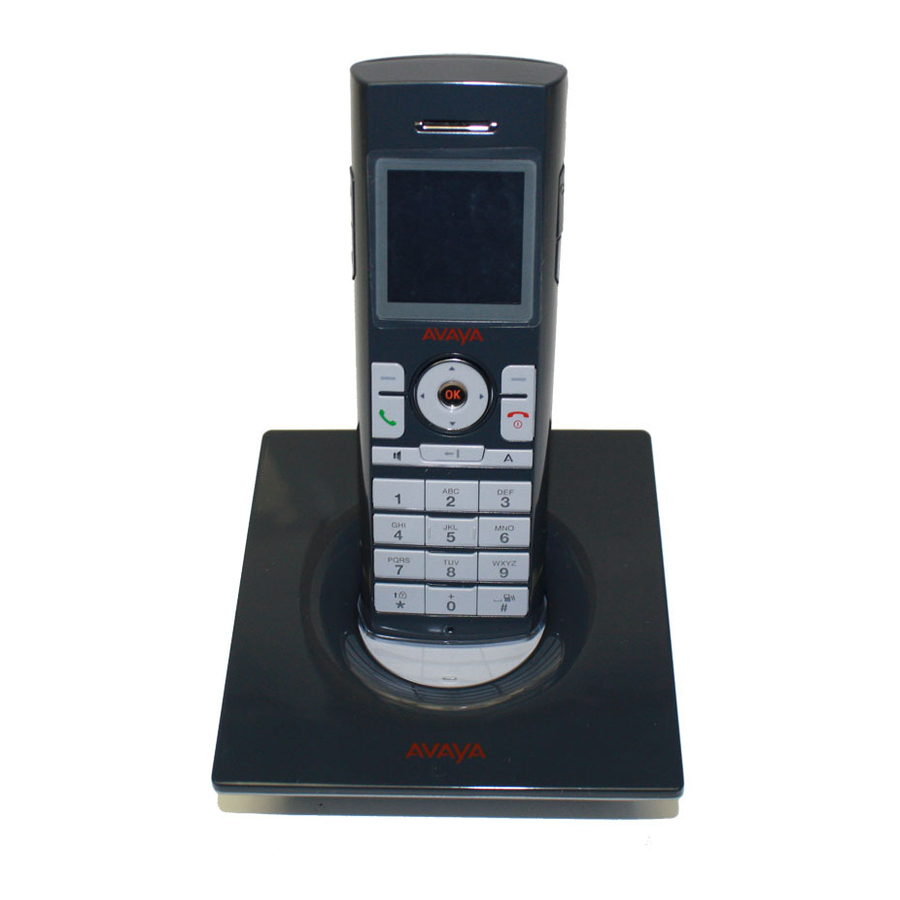- ページ 3
電話 Avaya 3645のPDF インストレーション・マニュアルをオンラインで閲覧またはダウンロードできます。Avaya 3645 19 ページ。 Co-existence with ip wireless handset offering
Avaya 3645 にも: クイック・リファレンス・マニュアル (2 ページ), 設定マニュアル (8 ページ)

Installation Guide
Introduction
Wi-Fi telephony enables the convergence of wireless voice and data applications using a common
wireless local area network (WLAN). Wi-Fi telephony bridges traditional telecommunications, data
communications and mobile technologies, resulting in ease-of-use and cost savings. A Wi-Fi–
enabled telephone is a WLAN client device, using the same network technology as wireless
laptops and PDAs. A Wi-Fi-enabled telephone can be functionally equivalent to a wired
telephone, and allowing for configuration and management from the local enterprise telephone
system. These benefits can result in substantial cost savings over other similar wireless
technologies by leveraging the Wi-Fi infrastructure and by eliminating recurring charges or
redundant costs.
However, a Wi-Fi telephone does impose different requirements on the network that result in
deployment considerations that differ from networks which are optimized for wireless data. Voice
and data applications have different attributes and therefore, different network requirements.
Because a Wi-Fi telephone is a mobile communication device, it requires special considerations
for continuous high-quality connections as a user moves throughout the coverage area. Another
significant difference is the tolerance for network errors and delays. Whereas data applications are
designed to accept frequent packet delays and retransmissions, voice quality will suffer with just a
few hundred milliseconds of delay or a very small percentage of lost packets. In addition, data
applications are typically bursty in terms of bandwidth utilization, while a telephone conversation
utilizes a consistent and relatively small amount of network bandwidth.
Using a WLAN for voice is not complex, but there are some aspects that must be considered,
particularly for enterprise applications. A critical objective in deploying enterprise Wi-Fi telephony
is to maintain similar voice quality, reliability and functionality as is expected in a wired telephone
environment. The key issues in deploying Wi-Fi telephony are coverage, capacity, quality of
service (QoS), telephone switch integration and wireless security.
2.0 Wireless LAN Layout Considerations
Avaya model 3616, 3620, 3626, 3641, and 3645 wireless telephones utilize a Wi-Fi network consisting
of WLAN Access Points (APs) distributed throughout an enterprise environment. The required number
and placement of APs in a given environment is driven by several factors, including intended coverage
area, system capacity, access point type, power output, physical environment, and radio type.
2.1 Coverage
One of the most critical considerations in deployment of Avaya wireless telephones is to ensure
sufficient wireless coverage. Enterprise Wi-Fi networks are often initially laid out for data applications
and may not provide adequate coverage for Wi-Fi telephony. Such networks may be designed to only
cover areas where data terminals are used and may not include coverage in other areas such as
stairwells, break rooms or building entrances – all places where telephone conversations are likely to
occur.
The overall quality of coverage is more important with telephony applications. Coverage that may be
suitable for data applications may not be seamless enough to support the requirements of Wi-Fi
telephony. Most data communication protocols provide a mechanism for retransmission of lost or
corrupted packets. Delays caused by retransmissions are not harmful or even discernable, for most
data applications. However, the real-time nature of a full-duplex telephone conversation requires that
voice packets be received correctly within tens of milliseconds of their transmission. There is little time
for retransmission, and lost or corrupted packets must be discarded. In areas of poor wireless
coverage, the performance of data applications may be acceptable due to retransmission of data
packets, but for real-time voice, audio quality will likely suffer.
Another factor to consider when determining the coverage area is the device usage. Wireless
telephone devices are used differently than wireless data terminals. Wireless telephone users tend to
Octiober 2008
3
